
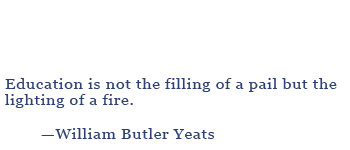
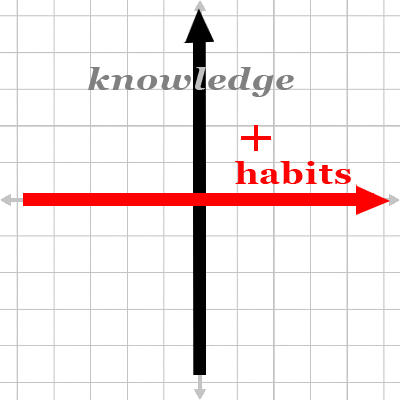
My Approach: The Whole Student
It's very gratifying to share an overview of my approach to tutoring because I have put a great deal of thought into the topic. Thousands of hours spent with students have given me a privileged view on the true essentials of what's going on in every learning endeavor, and how best to help students in the shortest time for the longest duration—preferably for life!
The diagram pictured on this page places the two essential ingredients to learning on a pair of perpendicular axes. The vertical axis represents knowledge. It occurs vertically because knowledge is cumulative and it is something we raise over time. We take it upward. Any tutoring situation will involve some degree of knowlege increase, so that students come away from the exchange with more skills in the area they are hoping to improve. With more knowledge, they are equipped to. Unfortunately, most tutoring emphasizes only this axis.
The horizontal axis, however, is the true rocket fuel in a successful learning relationship. I have labeled that axis "habits". It is a container of all the personality-based things students inevitably bring to the table that hinder their quality of learning apart from lacking knowledge of the subject. These various hindrances include, but are not limited to, diminished confidence, anxiety, fear of failure, alienation from self and personal achievement, reflexive boredom, and latent or manifest stigmas, which generally turn into self-fulfilling prophecies of failure. Things need not reach that point, but even if they do, a tutor with an eye on the horizontal axis is the only tutor whose help will remedy these habits.
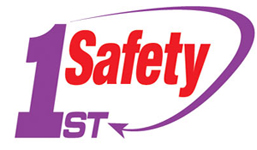
My Method: Safety and Support
So how, specifically, will I address these things? What approach do I use to take students forward (→right to left→) on the horizontal access of habit? For my students it mostly appears that I am catching them out in a friendly and good-natured way at each and every unconscious habit that detracts from their test performance, homework results, concentration, etc. For example, if a student rushes through an SAT reading passage to gain more time for the questions that follow it, I will painstakingly demonstrate how the counter-intuitive approach to do the opposite works much better, and the student will experience it to, and therefore change the habit. That is, I observe the habit, expose it, mutually question it, and position the student to test the new perspective on it experimentally, so that the student has living proof of what works better, and for that reason never does otherwise again.
The essential foundation for this form of positive, lasting discovery is an atmosphere of total safety for students to make mistakes without being judged for them. My students are often visibly surprised—and more often visibly relieved—when I tell them in our first session that mistakes are not only tolerated—they are celebrated! Why? Because mistakes are the inner wisdom of the student expressing its recognition that here certainly, in the company of a trustworthy tutor, it is the highest intelligence to reveal everything that needs help—the sooner, the smarter! I revisit this principle as often as it serves a student's growth. I speak about it explicitly with my students without going into the pyschological principles it contains.
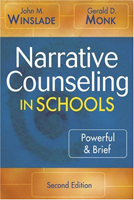
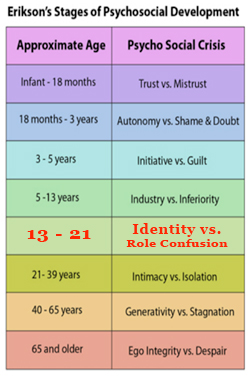
My Secret: Psychology
What I'll say next seldom, or actually never, comes up with my students. When I tutor, I often employ a powerful formal methodology derived from the field of counseling. Remember: I'm a licensed therapist, which enriches the tutoring. The technique is Narrative Counseling, and over the last ten years it has gained momentum nationwide in secondary schools and colleges as a reliable, constructive means to receive people and students as they are and help them reconstruct any harmful stories that currently define them. These stories, referred to in this context as narratives, hold people back immensely, but can also change for the best. People tell these stories to themselves regardless of where the stories originated. As a tutor I often follow the Narrative Counseling practice of redirecting a student away from an emphasis on demoralizing stories in exchange for a credible recognition of neglected strengths that are not getting proper air-time as a result. From there the student starts to reclaim and rewrite the stories with new, revitalized content that serves the universal ambition in all students for self-directed, self-sufficient success. I don't overly discuss this process with my students. I do reflect on it frequently on my own.
Similarly, I do not mention to students that viewed along the illuminating spectrum of Erik Erikson's 8 Stages of Psychosocial Development, most adolescents are dealing directly with Stage 5: Identity vs. Role Confusion. That's how Erikson described it. He was talking about the stage in our lifespan when we are beginning to fathom how our individual selves fit into the bigger picture of the adult world awaiting us. In the best case, adolescents develop a sense of identity that has integrity and holds together without rigidity. In the worst, they never figure out what their role is, but overly malinger in the ceaseless exploration of numerous possibiltiies without truly finding one. When I work with high school students, I earnestly consider these lifespan benchmarks, never to produce any specific outcome or agenda, but simply because my personal sense of ethics as a tutor compels me to care.
© 2018 graham best superiortutor.com
(powered by thinking)